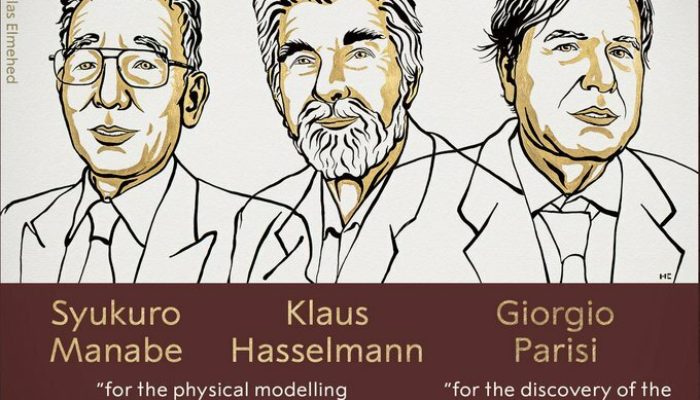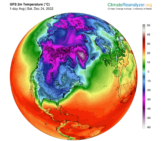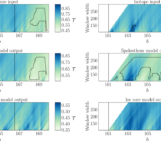
On October 7th, the Nobel Prize in Physics 2021 was announced. It came as a stunning surprise for the Non-linear Processes and Climate communities, the recipients of this year’s award being two outstanding senior climate scientists, Klaus Hasselmann and Syukuro Manabe, and a theoretical physicist specialized in complex systems, Giorgio Parisi. For many, this award was welcomed as a long-awaited recognition of the rigorous and robust physical foundations of climate sciences. More importantly, the Nobel Prize’s committee placed the “climate problem” in the wider context of disordered complex systems, recognizing that the methodological tools developed in the field of statistical mechanics, non-equilibrium thermodynamics, and dynamical system theory, find incredibly powerful applications in the way we currently understand and predict the dynamics of the atmosphere and oceans. Quoting the Scientific Background on the Nobel Prize in Physics 2021 [1], this year’s laureates understood that “no single prediction of anything can be taken as inviolable truth, and that without soberly probing the origins of variability we cannot understand the behavior of any system”, or, using a comment ascribed to Richard Feynman, he: “Believed in the primacy of doubt, not as a blemish on our ability to know, but as the essence of knowing.” [2]
Japanese-born Syukuro Manabe, presently senior meteorologist at Princeton University, provided an undisputed contribution to the development of the first numerical models for weather and climate, together with Joseph Smagorinsky at GFDL and Jim Hansen at GISS. His work on radiative-convective models [3], including radiative transfer modules in early-era GFD models [4], are milestones for our current understanding of the greenhouse effect, its influence on the hydrological cycle, and ultimately our ability to predict long-term climate response [5][6].
Klaus Hasselmann, born and educated in Hamburg (although living in the UK in the years of the Second World War, with his family fleeing from the atrocities of the Nazis), is currently Professor Emeritus at the University of Hamburg, formerly founding director of the Max Planck Institute for Meteorology. His revolutionary insight was to describe climate variability in terms of what was ultimately understood as a generalized Langevin equation (e.g. [7]), with a timescale separation between modes of the climate response and weather, with the latter treated as stochastic noise [8][9], This was a breakthrough achievement, seminal to many fields of modern climate science. In particular, this approach proved essential for numerical modelling, when it comes to the formulation of sub-grid scale processes through so-called stochastic parametrisations (eg. [10][11] for a theoretical framework). Moreover, the Nobel committee recognised the relevance of the optimal fingerprinting approach for the detection of the anthropogenic climate change signal [12].
It is perhaps less intuitive to recognise the outcome of research studies by Giorgio Parisi, professor at Sapienza University of Rome, president of the Accademia dei Lincei, in terms of advances in the field of climate change studies. Many in the NP community might be familiar with the concept of “stochastic resonance” [13] and the effect of macroscopic fluctuations on the transition of a chaotic system from one statistically steady state to another. Together with Catherine Nicolis, who was independently developing a similar idea at the Royal Meteorological Institute of Belgium [14], Parisi, Roberto Benzi, Alfonso Sutera and Angelo Vulpiani, formalised this idea in the early 80s, with many implications for the study of tipping points and abrupt transitions in the climate system [15][16]. Parisi was actually awarded the Nobel Prize on a different basis, especially for his discoveries on the behavior of spin glasses and the Ising model for ferromagnets [17][18]. Even if the behavior of ferromagnets might sound nothing like familiar to a climate scientist, it should not be surprising that researchers, such as Ken Golden at Utah University, are actually trying to understand and model the behavior of melt ponds over sea ice, with their huge implications for the sea-ice albedo feedback and the climate change signal as a result, by adapting an Ising model of phase transitions [19]!
The incredible careers and multi-disciplinary scientific achievements of this year’s Nobel laureates, bridging the gap between climate studies and so many different fields of research, are the evidence that non-linear mechanisms in complex chaotic systems are a genuinely fundamental and highly relevant physical problem.
[1] Advanced information. NobelPrize.org. Nobel Prize Outreach AB 2021. Tue. 19 Oct 2021.
[2] Gleick J (1992) Genius: The Life and Science of Richard Feynman, pp. 489 (Open Road Integr. Media, New York.)
[3] Manabe S, and Wetherald RT (1967) Thermal Equilibrium of the Atmosphere with a Given Distribution of Relative Humidity, Journal of the Atmospheric Sciences, vol. 24, pp. 241-259, http://dx.doi.org/10.1175/1520-0469(1967)0242.0.CO;2
[4] Manabe S (1970) “The Dependence of Atmospheric Temperature on the Concentration of Carbon Dioxide”, Global Effects of Environmental Pollution, pp. 25-29, http://dx.doi.org/10.1007/978-94-010-3290-2_4
[5] Manabe S, and Stouffer RJ (1993) Century-scale effects of increased atmospheric C02 on the ocean–atmosphere system, Nature, vol. 364, pp. 215-218, http://dx.doi.org/10.1038/364215a0
[6] Manabe S (2019) Role of greenhouse gas in climate change”, Tellus A: Dynamic Meteorology and Oceanography, vol. 71, pp. 1620078 http://dx.doi.org/10.1080/16000870.2019.1620078
[7] Watkins NW, Chapman SC, Chechkin A, Ford I, Klages R, Stainforth DA (2021) On Generalized Langevin Dynamics and the Modelling of Global Mean Temperature. In: Braha D. et al. (eds) Unifying Themes in Complex Systems X. ICCS 2020. Springer Proceedings in Complexity. Springer, Cham. https://doi.org/10.1007/978-3-030-67318-5_29
[8] Hasselmann K (1976). Stochastic climate models part I. Theory. Tellus 28(6), 473-485
[9] Hasselmann K (1979). On the Signal-to-Noise Problem in Atmospheric Response Studies. In: Meteorology of Tropical Oceans. Ed. by D.B. Shaw. London: Roy Meteorol Soc., pp. 251- 259
[10] Majda AJ, Timofeyev I, and Vanden-Eijnden E. (2001). A mathematical framework for stochastic climate models. Commun. Pure Appl. Math. 54, 891-974
[11] Ghil M, and Lucarini, V (2020). The physics of climate variability and climate change. Reviews of Modern Physics, 92(3), 035002
[12] Hasselmann K (1993) Optimal Fingerprints for the Detection of Time-Dependent Climate Change. J. Climate 6, 1957-1971
[13] Benzi R, Sutera A, and Vulpiani A. (1981). The mechanism of stochastic resonance. Journal of Physics A: mathematical and general, 14(11), L453
[14] Nicolis C (1081) Solar variability and stochastic effects on climate. Sol Phys 74, 473–478 https://doi.org/10.1007/BF00154530
[15] Benzi R, Parisi G, Sutera A, and Vulpiani A (1982), Stochastic resonance in climatic change. Tellus, 34: 10-16. https://doi.org/10.1111/j.2153-3490.1982.tb01787.x
[16] Ganopolski A and Rahmstorf S (2002). Abrupt glacial climate changes due to stochastic resonance. Physical Review Letters, 88(3), 038501
[17] Parisi G (1979) Toward a Mean Field Theory for Spin Glasses. Phys. Lett. A 73, 203
[18] Parisi G (1979) Infinite number of order parameters for spin-glasses Phys. Rev. Lett. 43, 1754
[19] Ma Y-P, Sudakov I., Strong, C, and Golden KM (2019). Ising model for melt ponds on Arctic sea ice. New Journal of Physics, 21(6), 063029. httpWe s://doi.org/10.1088/1367-2630/AB26DB




Francois Schmitt
You can also mention the contribution of G. Parisi to scaling and intermittency studies in turbulence and geosciences. And the introduction of the Legendre transform to relate the moment function and the codimension function, with the first mention of the word “multifractal” in the 1985 Parisi-Frisch paper.
http://www-thphys.physics.ox.ac.uk/people/AlexanderSchekochihin/wpi/workshop2_pdfs/frisch2.pdf